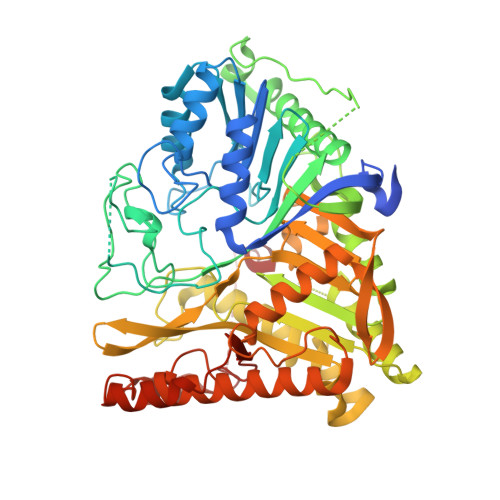Discovery of Phospholipase D Inhibitors with Improved Drug-like Properties and Central Nervous System Penetrance.
May-Dracka, T.L., Gao, F., Hopkins, B.T., Hronowski, X., Chen, T., Chodaparambil, J.V., Metrick, C.M., Cullivan, M., Enyedy, I., Kaliszczak, M., Kankel, M.W., Marx, I., Michell-Robinson, M.A., Murugan, P., Kumar, P.R., Rooney, M., Schuman, E., Sen, A., Wang, T., Ye, T., Peterson, E.A.(2022) ACS Med Chem Lett 13: 665-673
- PubMed: 35450377
- DOI: https://doi.org/10.1021/acsmedchemlett.1c00682
- Primary Citation of Related Structures:
7SVP - PubMed Abstract:
Phospholipase D (PLD) is a phospholipase enzyme responsible for hydrolyzing phosphatidylcholine into the lipid signaling molecule, phosphatidic acid, and choline. From a therapeutic perspective, PLD has been implicated in human cancer progression as well as a target for neurodegenerative diseases, including Alzheimer's. Moreover, knockdown of PLD rescues the ALS phenotype in multiple Drosophila models of ALS (amyotrophic lateral sclerosis) and displays modest motor benefits in an SOD1 ALS mouse model. To further validate whether inhibiting PLD is beneficial for the treatment of ALS, a brain penetrant small molecule inhibitor with suitable PK properties to test in an ALS animal model is needed. Using a combination of ligand-based drug discovery and structure-based design, a dual PLD1/PLD2 inhibitor was discovered that is single digit nanomolar in the Calu-1 cell assay and has suitable PK properties for in vivo studies. To capture the in vivo measurement of PLD inhibition, a transphosphatidylation pharmacodynamic LC-MS assay was developed, in which a dual PLD1/PLD2 inhibitor was found to reduce PLD activity by 15-20-fold.
- Biotherapeutic and Medicinal Sciences, Neuromuscular & Movement Disorders Research Unit, Research and Early Development Biomarkers, Biogen, 225 Binney Street, Cambridge, Massachusetts 02142, United States.
Organizational Affiliation:

















